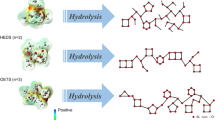Abstract
Interaction of molybdenyl(VI) bis(acetylacetonate) with polyphenylsiloxane in xylene and under mechanochemical activation conditions has been investigated. The interaction in solution proceeds with splitting of the siloxane bond and formation of polymolybdenum(VI) phenylsiloxane with different silicon/metal ratios. The fractions with the silicon/metal ratio < 2 are characterized with high degree of crystallinity and low solubility, whereas those with the ratio > 2 are amorphous. The interaction of the above reagents under mechanical activation conditions proceeds with the formation of soluble polymers similar to those obtained in a solution with the silicon/molybdenum ratio equal to 2.6. The crystal chemistry parameters of the fraction obtained in solution with the ratio Si/Mo equals to 1:2 have been calculated on the basis of the X-ray diffraction analysis data using the Debye–Shearer equation. It has been demonstrated that the chain cross section found using the Miller–Boyer method coincides with that calculated geometrically on the basis of literature data on bond lengths and angles. It is shown that the interaction of molybdenyl(VI) bis(acetylacetonate) with polyphenylsiloxane takes place in solution more deeply than under the conditions of mechanochemical activation and is accompanied by the process of separation siloxanes connection. This leads to the formation of a fraction with smaller ratio of substances than the initial ratio.






Similar content being viewed by others
References
Baňares MA, Hu H, Wachs IE (1994) Molybdena on silica catalysts: role of preparation methods on the structure-selectivity properties for the oxidation of methanol. J Catal 150:407–420. https://doi.org/10.1006/jcat.1994.1359
Wada K, Yoshida K, Watanabe Y (1995) Selective photooxidation of light alkanes to oxygenates using supported molybdenum oxide catalysts. J Chem Soc Faraday Trans 91:1647–1649. https://doi.org/10.1039/FT9959101647
Van Der Voort Pascal, Mitchell Mark B, Vansant Etienne F, White Mark G (1997) The uses of polynuclear metal complexes to develop designed dispersions of supported metal oxides: part I. Synthesis and characterization. Interface Sci 5:169–197. https://doi.org/10.1023/A:1008669528505
Van der Voort P, Van Wekzenis R, de Ridder M, Brongersma HH, Baltes M, Mathieu M, Vande Ven PC, Vansant EF (2002) Controlled deposition of iron oxide on the surface of zirconia by the molecular designed dispersion of Fe(acac)3. A spectroscopic study. Langmuir 18:4420–4425. https://doi.org/10.1021/la025679u
Kenvin JC, White MG, Mitchell MB (1991) Preparation and characterization of supported mononuclear metal complexes as model catalysts. Langmuir 7:1198–1204. https://doi.org/10.1021/la00054a030
Feher FJ, Blanski RL (1990) Polyhedral oligometallasilasesquioxanes as models for silica-supported catalysts: chromium attached to two vicinal siloxy groups. J Chem Soc Chem Commun. https://doi.org/10.1039/C39900001614
Collart O, Van Der Voort P, Vansant EF, Gustin E, Bouwen A, Schoemaker D, Ramachandra Rao R, Weckhuysen BM, Schoonheydt RA (1999) Spectroscopic characterization of an MoOx layer on the surface of silica. An evaluation of the molecular designed dispersion method. Phys Chem 1:4099–4104. https://doi.org/10.1039/a903110c
Papynov EK, Shapkin NP (2009) Solid waste disposal using thermal cracking. Russ J Chem Technol 10:48–52 (ISSN 0579-2991)
Shapkin NP, Zolotar’ GYa, Shapkina VYa (1983) Investigation of the interaction of phenylhydroxysilanes with iron three acetylacetonate. Deposited ONIITEKChem. 420-XII D 83
Shapkin NP, Zolotar’ GYa, Shapkina VYa, Bessonova VI, Alikovsky AV (1985) Interaction of gallium acetylacetonates, nickel, copper with diphenylsilanediol. Deposited ONIITEKChem. 753 XII-85 D
Kapustina AA, Shapkin NP, Makedonskaya ES (2010) Synthesis of ferrodiphenylsiloxanes by the method of mechanochemical activation. Butler Bull 19:7–11 (ISSN: 2074-0212)
Leont’ev LB, Shapkin NP, Leont’ev AL, Makarov VN (2016) RF Patent 2580270. Bull. 3
Tutov MV, Shapkin NP, Kondrikov NB, Kuryavyi VG (2015) Formation of nanostructured light guiding films based on octavinylsilsesquioxane and polyvinylsilsesquioxane using structured aluminum oxide. Russ J Nanotechnol 10:90–94
Andrianov KA, Khananashvili LM (1973) Technology of organometallic monomers and polymers. Chemistry, Moscow
Shapkin NP, Kul’chin YuN, Razov VI, Voznesenskii SS, Bazhenov VV, Tutov MV, Stavnistyi NN, Kuryavyi VG, Slobodyuk AB (2011) The study of polyvinylpolyphenylsilsesquioxanes using X-ray diffractometry, positron diagnostics, Si29 NMR spectroscopy and the study of films based on them. Russ Chem Bull 60:1640–1646. https://doi.org/10.1007/s11172-011-0245-1
Krasochka ON, Sokolova YuA, Atovnyan LO (1975) Crystal and molecular structures of molybdenum bis-acetylacetonate, MoO2(C5H7O2)2. J Struct Chem 16:648–650
Miller RL, Boyer RF (1984) Regularities in X-ray scattering patterns from amorphous polymers. J Polymer Sci 22:2043–2050. https://doi.org/10.1002/pol.1984.180221204
Shapkin NP, Leont’ev LB, Makarov VN, Khal’chenko IG, Korochentsev VV, Shkuratov AL (2014) Vermiculite-based organosilicate antifriction composites as coatings on friction surfaces of steel articles. Russ J Appl Chem 87:1810–1816. https://doi.org/10.1134/s1070427214120039
Brown JF, Vogt LH, Prescott PJ (1964) Preparation and characterization of the lower equilibrated phenylsilsesquioxanes. J Am Chem Soc 86:1120–1125
Jones MM (1959) A new method of preparing some acetylacetonate complexes. J Am Chem Soc 81:3188–3189. https://doi.org/10.1021/ja01522a005
Shapkin NP, Balanov MI, Razov VI, Gardionov SV, Mayorov VY, Tokar EA, Papynov EK, Korochentsev VV, Leont’ev LB, Slobodyuk AB, Modin EB (2018) Staircase polymetalsilicon nanocomplexes: polymetalphenyl siloxanes—structure and properties. J Mol Struct 1156:424–432. https://doi.org/10.1016/j.molstruc.2017.11.119
Acknowledgements
The rest of the work was financially supported by a grant from the Ministry of Education and Science of the Russian Federation (Project No. 4.8063.2017/8.9).
Author information
Authors and Affiliations
Corresponding author
Additional information
Publisher's Note
Springer Nature remains neutral with regard to jurisdictional claims in published maps and institutional affiliations.
Rights and permissions
About this article
Cite this article
Shapkin, N.P., Kapustina, A.A., Dombai, N.V. et al. Synthesis and physicochemical characteristics of polymolybdenum(VI) phenylsiloxanes by means of different methods. Polym. Bull. 77, 1177–1190 (2020). https://doi.org/10.1007/s00289-019-02790-3
Received:
Revised:
Accepted:
Published:
Issue Date:
DOI: https://doi.org/10.1007/s00289-019-02790-3




